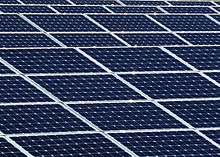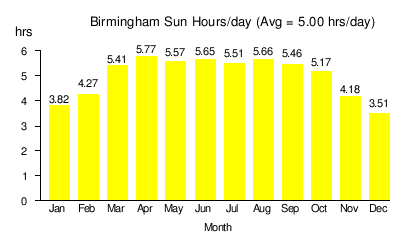Solar power in Alabama
Solar power in Alabama on rooftops could theoretically provide 29.8% of all electricity used in Alabama, with 20,400 MW of solar panels potentially installed on rooftops.[1]

Net metering
Offering net metering is required by federal law, but Alabama is one of only four states to not have adopted a statewide policy on net metering, which means it needs to be negotiated with the utility.[2] IREC best practices, based on experience, recommends no limits to net metering, individual or aggregate, and perpetual roll over of kWh credits.[3]
Alabama Power has installed four types of solar panels in Birmingham that can be monitored on the Internet.[4] The company will pay up to 4.81¢/kWh during the summer and 3.93¢/kWh in the winter for excess generation from up to 100 kW systems.[5] Peak power rates are weekdays, 1 to 7 pm in summer and 5 to 9 am in winter.[6] Customers choosing the Time Advantage Energy rate pay 7¢/kWh during winter peak periods and 25¢/kWh during summer peak periods. Off peak is charged 5¢/kWh. Using time advantage requires a time of use meter, and the base charge is increased by $10.50 each month.[7]
Projects
In 2010, one of Alabama's largest solar arrays was the 25 kW system installed at the Coastal Response Center, in Coden, Alabama.[8][9] A $250,000 economic stimulus grant was used to install 156 solar panels on Anniston's Museum of Natural History, which was completed on August 24, 2011.[10] The output of this 25.2 kW system can also be monitored online.[11]
Statistics

|
| Year | Capacity | Installed | % Change |
|---|---|---|---|
| 2009 | 0.2 | 0.1 | 100% |
| 2010 | 0.4 | 0.2 | 100% |
| 2011 | 0.5 | 0.1 | 20% |
| 2012 | 1.1 | 0.6 | 120% |
| 2013 | 1.9 | 0.8 | 73% |
| 2014 | 1.9 | 0 | 0% |
| 2015 | 2 | 0.1 | 5% |
| 2016 | 105 | 103 | |
| 2017 | 215 | 110 | |
| 2018 | 263 | 48 | |
| 2019 | 283 | 20 |
References
- Rooftop Solar Photovoltaic Technical Potential in the United States
- Freeing the grid
- Net Metering and Interconnection Procedures Incorporating Best Practices
- Solar demonstration Archived 2012-06-18 at the Wayback Machine
- Purchase of Alternate Energy
- Time Advantage Rates FAQs
- Time Advantage Rate
- Community center now home to one of Alabama’s largest solar power systems
- Realtime output
- Alabama Focus on Solar Energy
- Anniston Museum Energy and Power
- "PV Watts". NREL. Retrieved 12 June 2012.
- Sherwood, Larry (August 2012). "U.S. Solar Market Trends 2011" (PDF). Interstate Renewable Energy Council (IREC). Archived from the original (PDF) on 2012-09-06. Retrieved 2012-08-16.
- Sherwood, Larry (June 2011). "U.S. Solar Market Trends 2010" (PDF). Interstate Renewable Energy Council (IREC). p. 20. Retrieved 2011-06-29.
- Sherwood, Larry (July 2010). "U.S. Solar Market Trends 2009" (PDF). Interstate Renewable Energy Council (IREC). p. 23. Archived from the original (PDF) on 2010-09-25. Retrieved 2010-07-28.
- Sherwood, Larry (July 2009). "U.S. Solar Market Trends 2008" (PDF). Interstate Renewable Energy Council (IREC). p. 16. Archived from the original (PDF) on 2009-11-23. Retrieved 2010-07-24.
- Sherwood, Larry (July 2012). "U.S. Solar Market Trends 2012" (PDF). Interstate Renewable Energy Council (IREC). p. 16. Retrieved 2013-10-11.
- Sherwood, Larry (July 2014). "U.S. Solar Market Trends 2013" (PDF). Interstate Renewable Energy Council (IREC). Retrieved 2014-09-26.
- Alabama Solar